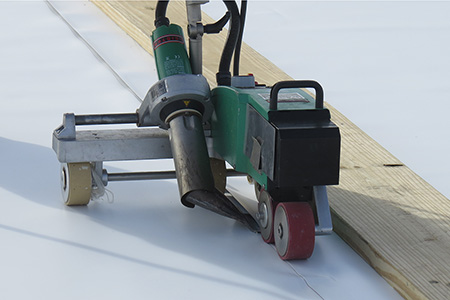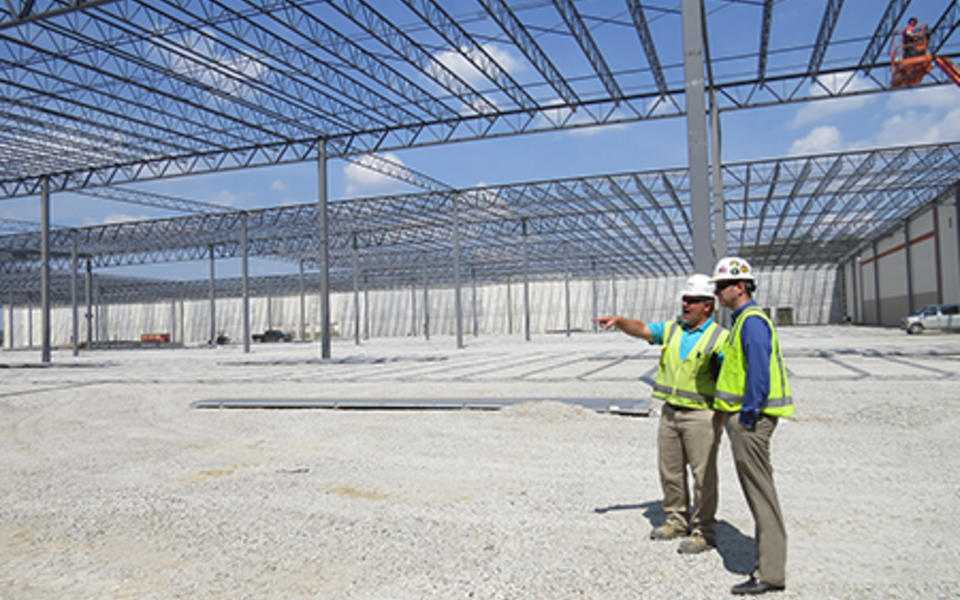Industrial and manufacturing, Quality
What do you need to consider when building a top performing industrial facility? This is the second post in a three-part series about important building components to consider when investing in your industrial facility: clear heights and bay spacing, building enclosure and the slab.
Industrial warehouses and distribution centers are designed more for function than aesthetic. Materials and systems are often selected for their energy efficiency. The building envelope includes the roof and exterior skin. The climate, building and energy codes and building use/operation affects the performance of materials, so we are constantly analyzing material trends for efficiency and their ability to meet today's energy standards. The building envelope includes the roof and exterior skin. These components provide opportunity for savings, and it's important to first understand the proper specification and installation.
01. Ensure longevity
Across the industry, we are seeing increased interest in extended roof warranties from developers and end users. There are two types of warranties to obtain for roofing: a manufacturer’s standard material warranty for the membrane and a no-dollar-limit warranty (NDL) for building systems. The NDL warranty provides important coverage for any deficiencies in the system as well as the labor and materials necessary to make corrections. Both can be purchased to cover 10-, 15- and 20-year roof options for a minimal cost ($0.04/SF-0.10/SF). These warranties offer a very cost-effective insurance policy for a long-term building owner.
02. Consider roof alternatives
With current energy codes dictating the minimum insulation R-Values for roofs and the predominate use of thermoplastic olefin (TPO) white membrane roofs and high efficiency HVAC systems, buildings have become dramatically more energy efficient in recent years.
With current energy codes dictating the minimum insulation R-Values for roofs and the predominate use of thermoplastic olefin (TPO) white membrane roofs and high efficiency HVAC systems, buildings have become dramatically more energy efficient in recent years.
For example, 20 years ago the roof insulation R-Value for a warehouse in the Midwest was R-12, which equated to 1.8 inches of insulation. Today, the R-Values range from R-25 to R-30, with R-30 equating to 5.2 inches of insulation.
When constructing industrial buildings, white, mechanically-fastened TPO roofs have become very popular. The initial appeal was primarily in warm climates due to their high solar reflectivity, which increases energy efficiency by keeping a building cool. However, as their use has spread across the country, new challenges have arisen within the Midwest and other cold climates where ballasted roofs have been traditionally used. These roofs are so effective in cooling the interior environment that, if not specified properly, they can cause condensation issues during colder months.
Industrial buildings are typically designed to be heated and ventilated with direct-fired-gas air handling units, such as positive pressure 80/20 units. With more than 95 percent efficiency, these units are able to bring in 20-100 percent outside air and place a building in a slightly positive pressure to control infiltration. If the mechanically fastened TPO roof system is not properly designed, the warm air generated can migrate through the roof deck and insulation joints to the underside of TPO membrane where condensation may form. In the winter this condensation will turn to ice and when the temperature goes above 32 degrees, the ice will melt and drip into the interior space.
To eliminate this issue, in cold climates we recommend a fully adhered TPO system where the membrane is glued to the top layer of insulation. At a minimum, if a mechanically fastened system is used, specify extra precautionary measures such as a vapor barrier, two layers of staggered insulation and foam around the perimeter and roof penetrations to prevent warm air from migrating through the system. The design, construction and consulting teams should collaboratively evaluate the building envelope from a holistic standpoint early in the design process – with particular focus on the functional relationship between the HVAC system and the roofing system – to proactively avoid any complications.
03. Consider the market
Consider the market when determining whether precast or tilt-wall will work best for the project. Each option can have major cost and schedule implications. Tilt-wall panels are cast on the jobsite, tilted into place, and then insulated on the inside face. Precast is made in a plant, with insulation sandwiched between the interior and exterior concrete wythe. Since it comes out of a controlled environment, quality and schedule can typically be controlled better with precast compared to tilt-wall, which is exposed to the elements and may take longer to install. While there are only a few precast manufacturers in the Midwest who can service the industrial market, and recent demand has pushed precast availability out to 8-10 months and increased prices by 25-30 percent, it is still a better alternative locally than tilt-wall.
While industrial projects may have similar building components, each client, location and project creates a unique set of priorities. Teaming with the right construction partner who will look for ways to successfully align their efforts with the client’s goals is critical. At Pepper, we take the time to properly analyze all aspects of a project from the early design stages through permitting to identify potential cost savings before work begins in the field – including value added design opportunities our clients haven't considered. Breaking ground means looking out for what’s next and giving our clients a competitive edge today.
In the last installment of this series, we will talk about the quality of the floors.
Click here to read the first installment, where my colleague Brian Lensink talked about marketability of industrial buildings.





